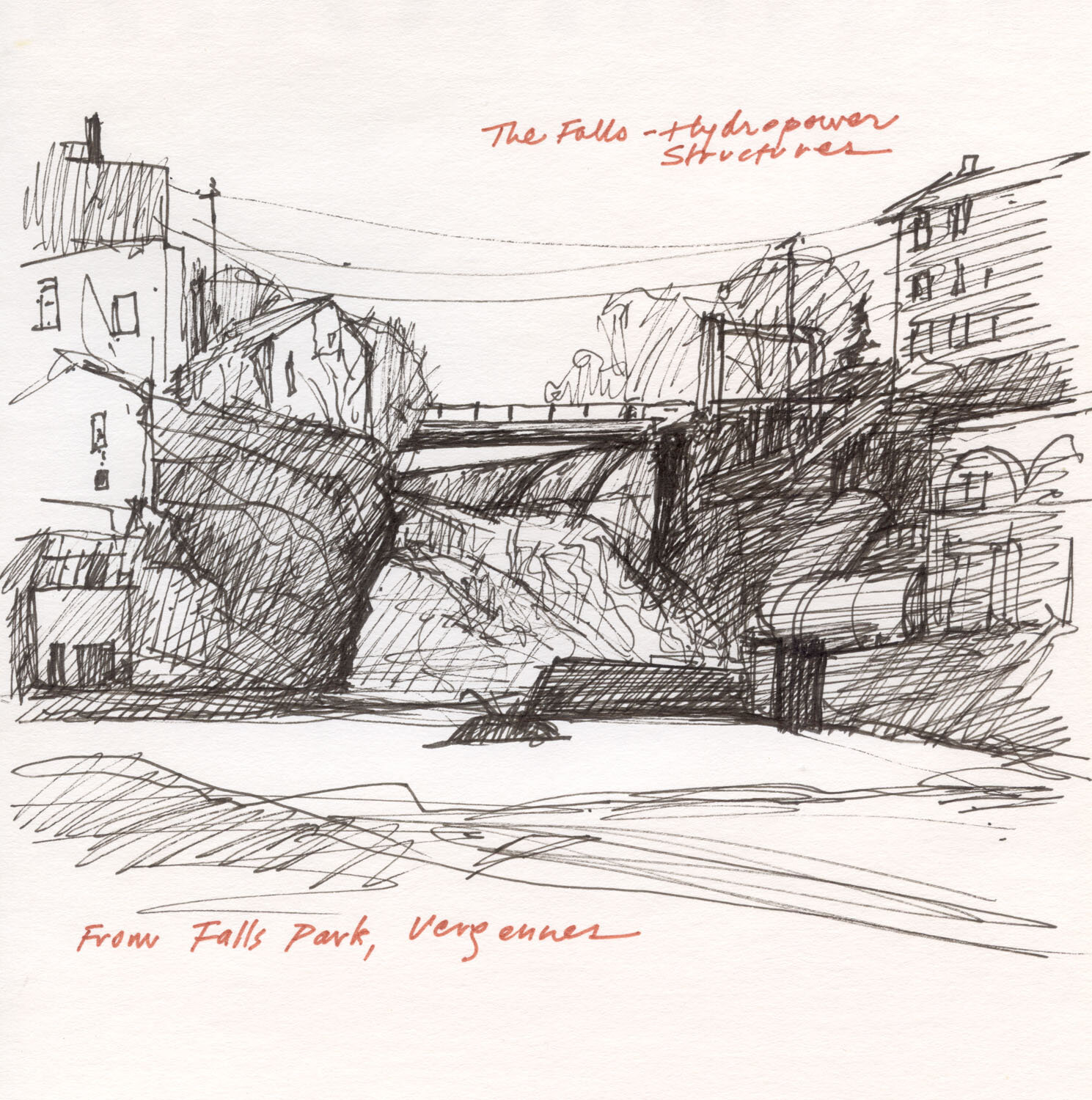Vergennes
Vergennes boasts that it is the smallest city in the United States.
Charles Edward Crane, “Let Me Show You Vermont”
What's the point of driving from town to town in my Toyota, juggling camera, map and sketchbook? I'm not an historian or economist gathering data, but I'm not just sightseeing either. I think this project is my way of trying to get a grasp on where I live, kind of like realizing that there's still much more to learn about a spouse twenty-five years into a marriage--and I did move to Vermont because I fell in love with the place. My way of understanding is to look, draw, paint, gather images. Love, art and road trips are passionate processes with indefinite conclusions.
So, I slow down as I drive into Vergennes on Route 22A, and take in the ornate building on the right, and the small factory on the left. Like everything else here, it looks really old; is it empty now, or put to a new use? I park, pick up my pen and sketchbook, and stroll down quiet Sunday Main Street.
The downtown of "the smallest city in the U.S." (in Vermont that’s a bragging right) is indeed old but still in wonderful shape. Ornate 19th century facades are fastidiously painted a spectrum of red, green, and yellow, and most buildings are occupied with the kind of trades and services that make a town useful to locals. Even the laundromat is elegant. High on the list of downtown’s services is Daily Chocolate, which I know from the gift box that my framer gives me every Christmas. Thanks, Steve!
As often happens in Vermont towns, I sense ghosts here. Vergennes’s heyday was in the 1800's, and today I'm looking at the beautifully maintained remnants of another century's energy, creativity and wealth. Many towns have a "Mechanic Street" built in the 1800’s during the boom times. I find Vergennes’s own version and follow it downhill a few blocks to Falls Park on Otter Creek.
As usual, a bet made on rambling pays off, this time with a jaw-dropping view of three powerful waterfalls tumbling past a jumble of old factories. Now I understand why Main Street is so fancy here, the library so large, and homes so ornate. It was all built on long vanished industrial money.
There’s a phantom Vergennes that I feel alive behind the empty factory facades on Mechanic Street. This was the first city in Vermont, and when established on Otter Creek in 1788, was a vital transportation hub serving stage coaches, river boats and then trains from up and down the East Coast. The falls provided energy for a self-sufficient economy: tanneries, grain mills, creameries and sawmills transformed and traded the bounty from miles of surrounding valley farms, and in return gave rural people the chance for store-bought goods, and a cultural life different from what they had before money was a currency here.
I drive back up to Main Street and take a closer look at a pretty little Italianate building perched on a patch of grass at the top of the falls. According to the historical marker, it was built by the owner of the town's machine shop to house a pumping system he invented. So here is a last ghost: the Vermonter who came off his father's farm with the skills and ambition to harness his city, state and the world itself to a new industrial dynamo.
The Vermont town had always been enclosed in a strong circle of self-sufficiency, but it couldn't hold against the competition from far away places that the industrial revolution—that Vermont genius and hard work helped create— unleashed.
I'll have to keep driving and looking, and try to figure out what of value vanished here when that circle of self-sufficiency broke, and what remains.



